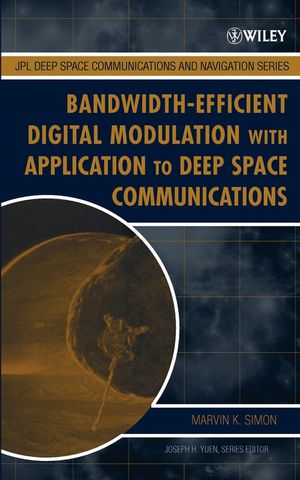Bandwidth-Efficient Digital Modulation with Application to Deep Space CommunicationsISBN: 978-0-471-44536-4
Hardcover
248 pages
February 2003
 This is a Print-on-Demand title. It will be printed specifically to fill your order. Please allow an additional 10-15 days delivery time. The book is not returnable.
|
||||||
Preface.
Chapter 1: Introduction.
Chapter 2: Constant Envelope Modulations.
2.1 The Need for Constant Envelope.
2.2 Quadriphase-Shift-Keying and Offset (Staggered) Quadriphase-Shift-Keying.
2.3 Differentially Encoded QPSK and Offset (Staggered) QPSK.
2.4 /4-QPSK: A Variation of Differentially Encoded QPSK with Instantaneous Amplitude Fluctuation Halfway between That of QPSK and OQPSK.
2.5 Power Spectral Density Considerations.
2.6 Ideal Receiver Performance.
2.7 Performance in the Presence of Nonideal Transmitters.
2.7.1 Modulator Imbalance and Amplifier Nonlinearity.
2.7.2 Data Imbalance.
2.8 Continuous Phase Modulation.
2.8.1 Full Response-MSK and SFSK.
2.8.2 Partial Response-Gaussian MSK.
2.9 Simulation Performance.
References.
Chapter 3: Quasi-Constant Envelope Modulations.
3.1 Brief Review of IJF-QPSK and SQORC and their Relation to FQPSK.
3.2 A Symbol-by-Symbol Cross-Correlator Mapping for FQPSK.
3.3 Enhanced FQPSK.
3.4 Interpretation of FQPSK as a Trellis-Coded Modulation.
3.5 Optimum Detection.
3.6 Suboptimum Detection.
3.6.1 Symbol-by-Symbol Detection.
3.6.2 Average Bit-Error Probability Performance.
3.6.3 Further Receiver Simplifications and FQPSK-B Performance.
3.7 Cross-Correlated Trellis-Coded Quadrature Modulation.
3.7.1 Description of the Transmitter.
3.7.2 Specific Embodiments.
3.8 Other Techniques.
3.8.1 Shaped Offset QPSK.
References.
Chapter 4: Bandwidth-Efficient Modulations with More Envelope Fluctuation.
4.1 Bandwidth-Efficient TCM with Prescribed Decoding Delay-Equal Signal Energie.
4.1.1 ISI-Based Transmitter Implementation.
4.1.2 Evaluation of the Power Spectral Density.
4.1.3 Optimizing the Bandwidth Efficiency.
4.2 Bandwidth-Efficient TCM with Prescribed Decoding Delay-Unequal Signal Energies.
References.
Chapter 5: Strictly Bandlimited Modulations with Large Envelope Fluctuation (Nyquist Signaling).
5.1 Binary Nyquist Signaling.
5.2 Multilevel and Quadrature Nyquist Signaling.
References.
Chapter 6: Summary.
6.1 Throughput Performance Comparisons.
References.



